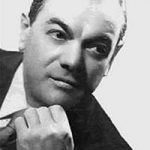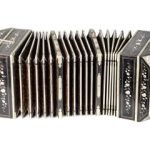Tango composer, pianist and orchestra leader Rodolfo Biagi was given the nickname “Manos Brujas (Spellbinding or Magic Hands)” for his energetic and easily recognizable rhythmic style.
Biagi was born on 14 March 1906 in Buenos Aires and gave up his studies after finishing grammar school. The young Biagi wished to devote himself entirely to music. Naturally, his parents disagreed, but they struck a deal. Biagi’s parents would buy the violin he wanted, but he had to enter the Escuela Normal de Profesores Mariano Acosta. Biagi, however, was drawn to the piano when he was enrolled at the conservatory of the newspaper “La Prensa.”
At thirteen years old, without his parents’ knowledge, Biagi made his debut as a pianist, playing the musical background for silent films at a local cinema. One evening, the maestro Juan Maglio had been to that very cinema and was impressed upon hearing the pianist. Maglio invited Biagi, then only fifteen, to play with him. Biagi later on would join the orchestra of bandoneonist Miguel Orlando at the cabaret Maipú Pigall.
By 1930, at the age of 24, Biagi was approached by José Razzano to accompany the famous tango singer, Carlos Gardel on some recordings. On the first of April of that year, Biagi recorded the tangos, “Viejo smoking”, “Buenos Aires” and “Aquellas farras”, the foxtrot “Yo seré para ti, tu serás para mí” and the waltz “Aromas de El Cairo” with the violinist Antonio Rodio and the guitarists Aguilar, Barbieri and Riverol. Gardel invited Biagi to join him on a tour of Spain, but Biagi declined.
He then joined several other orchestras, the Juan Bautista Guido orchestra and the orchestra of Juan Canaro. He met Juan Carlos Thorry during his time with the latter and composed with him the tango “Indiferencia.” Working with Canaro brought Biagi to Brazil and upon his comeback, Biagi left Canaro’s orchestra. Biagi remained inactive for a time, during which he was a frequent patron of the cabaret Chantecler, where his friend Juan D’Arienzo played. D’Arienzo’s pianist, Lidio Fasoli, was notoriously late for everything and one evening, D’Arienzo asked Biagi to replace him.
Biagi and D’Arienzo worked together for three years and during this time, Biagi established his defining style of playing. The D’Arienzo orchestra was a popular and successful group, appearing on the radio, at balls and clubs, going on tours and performing for Enrique Santos Discépolo’s movie “Melodías porteñas.”
When Biagi split with D’Arienzo, he put together his own orchestra, which made their debut on 16 September 1938 at the cabaret Marabu. His and D’Arienzo’s orchestras were crucial in the traditional positions of tango interpretation. Biagi had a show on Radio Belgrano which launched his nickname of “Manos Brujas” when he played a foxtrot by Jose Maria Aguilar at the beginning of each show. Biagi’s orchestra was the first to appear on Argentine television in the early fifties. His tango group saw many talents, including singers Jorge Ortiz, Alberto Lago, Alberto Amor and Carlos Acuña. Musicians such as Alfredo Attadía, Miguel Bonano, Ricardo Pedevilla, Marcos Larrosa, Claudio González and Oscar de la Fuente were also involved. Biagi performed for the last time in public on 2 August 1969 at the Hurlingham Club. Forty-one days later, on 24 September, he passed away from an extreme drop in blood pressure.





